|
Bristle/Fireworms Identification FAQs
5
Related FAQs: Polychaete ID 1, Polychaete ID 2, Polychaete ID 3, Polychaete ID 4, Bristleworm ID 6, Bristleworm ID 7, Bristleworm ID 8,
Bristleworm ID 9,
Bristleworm ID 10,
Bristleworm ID 11,
FAQs: Worm Diversity
FAQs, FAQs
2, FAQs 3, & Worm IDs
1, Worm IDs
2, Worm IDs 3, Worm IDs 4, Worm
IDs 5, Worm IDs 6, Worm IDs 7, Worm
IDs 8, & Worm ID FAQs by Group/Phylum: Flatworm Identification ID, Nemertean, Proboscis, Ribbon Worm ID,
Nematode, Roundworm ID,
Nematomorpha,
Horsehair Worm ID, Acanthocephalans,
Thorny-headed Worm ID, Tubeworm ID, Hirudineans, Leech ID, Sipunculids, Peanut Worm ID, Echiuran Worm ID, & Bristle/Fireworms 1, Bristle/Fireworms 2, Bristle/Fireworms 3, Bristle/Fireworms 4, Worm
Identification, Polychaete Behavior, Polychaete Compatibility, Polychaete System, Polychaete Selection, Polychaete Feeding, Polychaete Disease, Polychaete Reproduction,
Related Articles: Worms,
Polychaetes, Flatworms/Planaria,
|
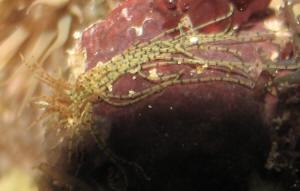
|
| What Kind of Worm???? Using WWM... 11/4/07
Would you please help me identify this worm? We found it while
cleaning a huge amount of green hair algae off of our live rock.
<Is a Polychaete... an Errantiate of some sort...> They are
about the thickness of a pencil and 3" to 4" long, there
are several of them. And could u <...> please tell me if it
is ok to have them or should I try to get rid of them. Thanks in
Advance for any help, Kandra <Please read here:
http://wetwebmedia.com/polychaeidfaqs.htm and the linked files
above. Bob Fenner> |
|
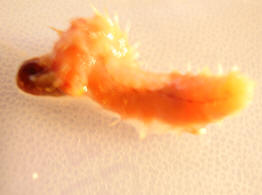
|
Large Bristleworm 10/26/07 So my
tank is in about its 4th week, and I've just found a rather large
(5 inch or thereabout) worm of some kind. He is blue/green in color,
and the closest I can come to describing him is that he looks like a
centipede of some kind. <Sounds like a Bristleworm.> He looks,
far as I can tell in my brief glances, something like this guy...but
again, I haven't gotten a super close up look at him. <Would not
be unexpected in your tank.> The questions are these...should I be
getting this guy outta there? <Normally I would say no, they are
quite beneficial scavengers, but this guy is starting to get pretty
big, I worry he might turn predatory of he can not find enough
food.> There's nothing dead in the tank: 5 live snails, 6 live
hermits, and a bunch of algae on live rock...that's it...is he
going to starve if I DON'T pull him? <Might> I'm VERY new
to this reef keeping hobby, and nearly fell over when I spotted a large
worm crawling through a rock...when I knew I hadn't put him in
there!!! Mitch <Its can be surprising what shows up on LR. At this
point if you can remove him I would, but I would not go to drastic
measures to do it.> <Chris>
Bobbit Worm? (Eunice Spp) 9/26/07 Even crew -
<Hello Hendy, Mich here this early morn.> you are all well I
trust? <I can only speak for myself and I am quite well thank
you!> One of my favourite pastimes is to feed the tank with a
prawn or lance fish after lights out and watch the "unseen
tank" perform it's clean up. <Even better with a red
light!> It's normally a free-for-all between the hermits,
Saron shrimps, coral banded shrimps and the usual mass of
polychaete worms. <Cool!> It has been like this for two tears
nearly. Nothing has changed and definitely no new rock. <OK.>
Imagine my surprise when this beastie showed up to claim the sand
eel tonight. <Heehee! Is a beastie for sure!> I am certain it
is a "Bobbit worm" Eunice sp. <I am in agreement with
your identification.> but it seems to lack the massive
chelicerae of the pictures in my books. It has a huge mouth which
rather reminds me of those aircraft where the nose & cabin
opens up to allow freight in and out as this worm definitely seems
to have a "flip-top head" <Heehee! A la a Muppet or
perhaps Julia Roberts?> and a good appetite to match. <Goes
with the "flip-top head"> I was worried at first but
having done a tiny bit of research, I am tempted to leave them (yes
there are at least two - the one in the photo, diameter of about
4mm and another tiny one about the width of a pencil lead) <If
there are two there could easily be more...> as I has witnessed
they are definitely good clean-up and increase the bio-diversity.
<True.> I don't seem to have a problem with fish
disappearing <Yet.> so either they are a non-predatory
species (a minority are I understand) <OK. You are making an
informed decision.> or they are getting enough to eat
<I'm leaning towards this.> - I often feed after dark to
keep my sand snails happy. <And many other creatures as
well!> Just after some advice from you <Well you seem to have
made a decision and an informed one at that. These are typically
predatory as you know.> - sorry the picture isn't great,
<No apologies! Actually, the pic is quite good! These guys are
hard to catch on "film".> but it took me ages to coax
it out with the fish <I can imagine.> - and they are timid of
the light and lightning fast <Super fast!> - had loads of
failed shots. <I bet!> All the best
<And to you Hendy! Mich>
Hendy |
|
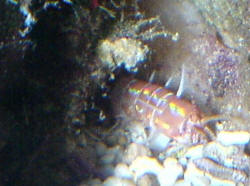
|
| ID Needed Please'� Egg Mass'� Perhaps of
a Polychaete Worm 8/30/07Hello, <Hi Brad, Mich
here.> I cannot thank you all enough for what you guys do for
us! <Just trying to help. Thank you for your kind words.>
That being said, I'm stumped on this one. Can you possibly ID
this for me? <I'll give it a try!> I have two of them
growing out of my sand bed, they are a bubble of some sort with
specks inside. Good/bad? <Excellent picture by the way. Is the
reproductive matter of something, an egg mass, likely an invert,
and from what I have read, but have been unable to find pictures to
really compare is it may be that of polychaete annelid worms.
Nothing to worry about and when they hatch, likely in a day or so,
it will make a tasty treat for your fish and corals.> Thank you
for your time in this matter! <Welcome! The Brad |
|
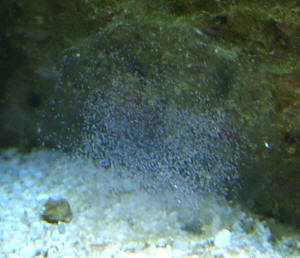
|
|
Id help: Epitoke - 8/14/07 Hey everyone, <Hey Noah>
I'll start with the required (but well deserved of course)
Wow your site is awesome, I love it. <Thanks!> Anyway, just
recently I found this odd little thing in my tank (pictures
included). The white part is the head, and it does seem to have
visible eyes, mouth, etc. It behaves very oddly. It will swim
like an eel to the top of my tank, sit there trying to get its
head out of the water (at least that's what it looks like),
then suddenly stop moving and sink to the bottom of the tank. It
does this entire cycle maybe once every 5 minutes. Any help would
be greatly appreciated. <Well Noah, what you've got there
is an epitoke, sometimes called a 'swarmer'. It's a
reproductive form of an errant polychaete worm (sorry - can't
quite see enough to give a better Id). There are several
different ways these worms reproduce. In this case, the back half
develops into a segment filled with gametes (eggs or sperm). When
the time is right (usually a phase of the lunar cycle), the worm
emerges and the posterior section breaks away. That section then
swims up into the water column, and releases its gametes in a
mass spawning event. The head/anterior section returns to the
bottom and regenerates. By the way, with only one of these
present in your tank, you don't have to worry about an
imminent plague of polychaetes! For more information, please
Google the terms 'epitoke' or 'epitoky'. Also,
here are a couple of photos of one I had in my tank for
comparison. It had a very similar looking segmented posterior
section and is in the Family Nereididae. Size-wise, it was a
little over 4.5' long.
http://wetwebfotos.com/usermedia/high/0/2470_44.jpg
http://wetwebfotos.com/usermedia/high/0/2470_46.jpg > Thank
you very much, Noah <You're very welcome! -Lynn>
Re: Id help: Epitoke - 8/14/07 Thanks again!
<Anytime, Noah! It's pretty strange to see something like
that swimming around in your tank, isn't it (but pretty neat
too!). <lol> I hate to admit it, but that one I
photographed initially scared the living daylights out of me.
I'd just woken up, the lights were still off in the tank, and
I went in for a close look to check things out. Evidently, the
worm had been floating/resting up at the surface, and suddenly
decided to zoom by, right in front of me. I jumped back about a
foot and let out the most embarrassingly girly shriek ever. I
laugh about it now, but at the time' yikes! The lesson I
learned was to avoid going in for those close-ups first thing in
the morning! I figure it spares me, as well as the creatures
living in my tank! <g> Anyway, it was a pleasure helping
you, and please let us know if there's anything else we can
do for you. --Lynn>
Re: Worm Identification, Follow-up - 8/17/07 Thanks
again crew! <You're very welcome!> Sadly, the little
guy was sucked into a powerhead last night.:( <Aw, I'm
sorry to hear that. Thank you for sharing the photos and
experience with us, though. By the way, here are several good
links for future reference re: polychaete Id:
http://www.reefkeeping.com/issues/2003-03/rs/index.php, and:
http://home2.pacific.net.ph/~sweetyummy42/hitchworms.html. Good
luck, and thanks for keeping in touch. -- Lynn>
|
|
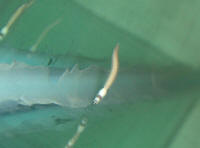 .JPG)
|
|
Re: Identification? Worm 8/15/07 Ill try to
find it and get it out of tank, should be able to get a close-up
of it then! <Real good>
Re: Identification? 8/16/07 Ok, so i got it
and looked at it under a microscope. It has 8 legs (or whatever
the proper term is) on each side of the forward half of the body.
It has two dark lines going from head to tail, and a visible
blood vessel (or something of the sort) that has a visible pulse.
It is about 3 mm wide at the front half, and 4-5 on the back. It
is about 14 mm long. Some more pictures are included, hopefully
they will be better. Noah <Ahh, thank you for these. I do
agree with Lynn that this is very likely an epitoke... a
"reproductive unit" of a polychaete... Very common in
the world's oceans... and not a worry. Bob Fenner>
|
|
.JPG)
|
Marine critter ID -- 07/18/07 Hi
Crew, I've written in several times before with freshwater
aquarium questions, but this time it's a matter of curiosity
rather than fish care. We're vacationing at Bald Head Island,
North Carolina. We were out in the sound at low tide and noticed
these guys on a sandbar, sticking up out of the sand with about an
inch exposed. As best we can tell, they're hollow, flexible
tubes made of cemented sand--or made of something else, and very
well coated with sand. They're three or four inches at the
longest, and never more than three millimeters wide. They look like
worm casings, but we've carefully dug around them, rather than
just pulling them up, and we've never found anything in or
under them. My brother's best guess is horseshoe worms, but the
casings aren't U-shaped. In fact, we found one tube with three
tubes branching off of it. <I think you've found the tubes
of some kind of Maldanidae worm, maybe a "bamboo worm" or
something similar. At first I also thought they were
parchment/horseshoe worms (Chaetopterus variopedatus). But as you
pointed out, they aren't u-shaped and they don't seem quite
as tough or big as Chaetopterus variopedatus worm tubes usually
are. There are Maldanidae worms which have narrower and more
brittle tubes made of sand and mucus. This seems to fit your
description and picture. However, I couldn't tell you which
species might be common in North Carolina. I suppose it's also
possible that these are just old, empty Chaetopterus worm tubes
that have just been broken up.> Attached is a picture. Obviously
it's not an urgent matter, but we'd appreciate a guess as
to what they are! <Btw, this is a cool site for beach findings
in North Carolina: www.okeefes.org/Marine_Life/marinelife.htm>
Thanks,
<No problem.
Best,
Sara> |
|
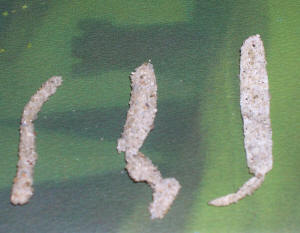
|
|
Bristleworm Regeneration 7/14/07 Dear Crew,
<Hi Eric, Mich here.> I have found conflicting information
on this on the web, and nothing specific here on WWM, so I
thought I'd ask. If, when trying to remove a bristleworm with
tweezers, said worm breaks in half, will the posterior portion of
the worm remaining in the tank regrow a head and survive?
<Theoretically, yes, it is possible, and has been done in a
laboratory setting. See the article below. However, I suspect it
is uncommon in an aquarium setting, particularly given the number
of segments you removed.
http://www.springerlink.com/content/uqhnrcw04vp7v9wa/ > The
worms I am specifically dealing with are large (8-10 inches)
<YIKES!!!!> and I believe are members of the Amphinomidae
family. (Please see attached photo.) <Yes, looks to be an
Eurythoe spp.> Thanks in <Welcome! Mich>
Eric
|
|
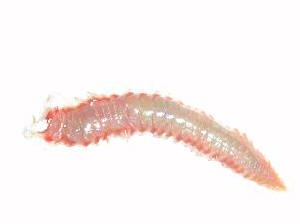
|
|
Red worms with black Rings?
7/8/07 Hey Crew! I have searched the website, but found no
definite answer. In my tank, these hair thin worms come out at
night in clusters. They come up from the sand in the same spot
every night. They are very thin colored pinkish red with small
black rings. I am worried that they are some type of parasite
that will either harm my fish or coral. If they are harmful, what
would be the best way to get rid of them. Thank you very much
guys. <No worries. They're most likely some kind of
Terebellid polychaete or "spaghetti worm" (highly
desirable and fascinating little critters). Each cluster is one
worm. Those thin hair-like things are the worm's feeding
tentacles. Please give no more thought to getting rid of them and
do enjoy them. :) > - R Delaney <Best, Sara M.>
Re: beautiful spaghetti worm 7/9/07 My bad... it's
a hair worm, not a spaghetti worm. Sara <Yes. RMF>
Re: Red worms with black Rings?
7/10/07 OK Great! Thank you so much. <No problem. I forgot
to say it could also be a "hair worm" (Cirratulid
polychaete). It doesn't really matter though. Both kinds of
worms are very good to have. :-) Sara M.>
|
|
.JPG)

|
|
|

